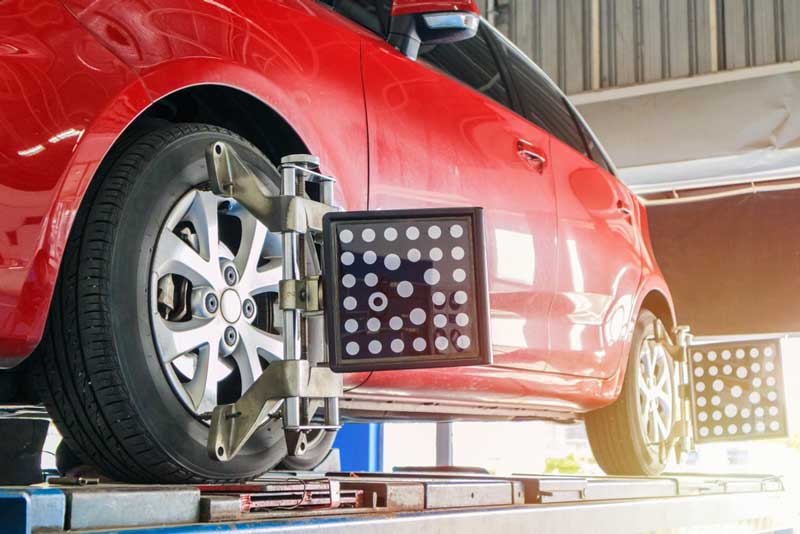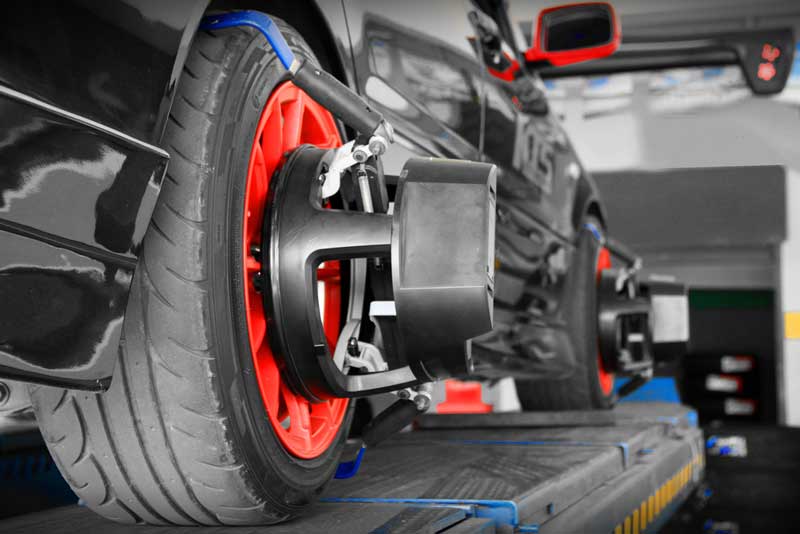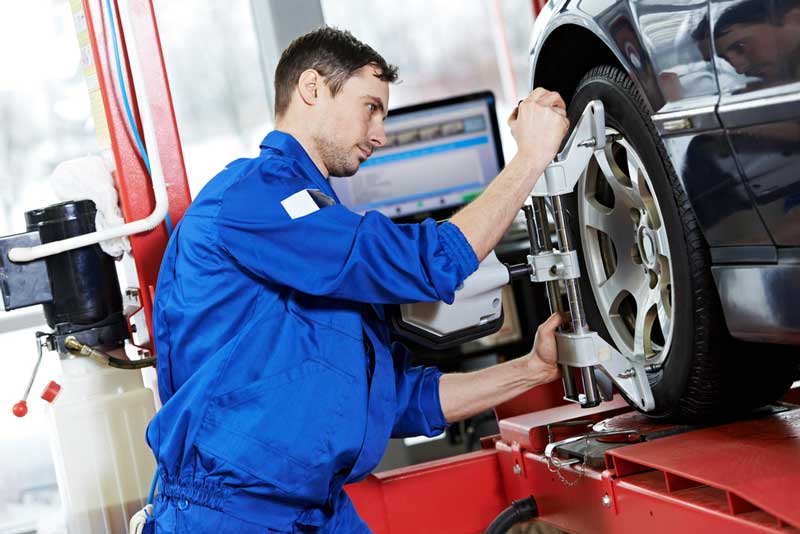Are you considering a wheel alignment and will like to know how much a Wheel Alignment Cost?
A vehicle owner decides to change his vehicle’s oil, and the mechanic informs him that the vehicle’s wheel needs an alignment. Can this be possible?
This may be true and not necessarily the workshop devising a means to earn more money to carry out some unnecessary repair on the vehicle. Although wheel alignment is an important maintenance procedure, they do a lot of good to the vehicle. So, what is the cost of having a Wheel alignment and the length of time used for the alignment?
Everything that needs to be known about this procedure will be discussed, including the cost of wheel alignment, how much time is needed for the alignment, and how frequently it should be done.
How Much Would A Wheel Alignment Cost?
The average cost of wheel alignment of the rear or front wheels most vehicles ranges from $50 to $100. To align all four wheels, expect to pay between $100 and $200. For the best result, a complete 4-wheel alignment is recommended.
The first factor is that the cost depends on how many wheels need alignment, whether one, two, or all the wheels. A four-wheel alignment usually costs more money than others because this alignment requires more work. A lot of recent vehicles usually require an alignment of all four wheels.
Another factor that may influence the price of a wheel alignment is how big the tires and wheels are. To carry out a wheel alignment on a vehicle with very large tires and wheels or a vehicle with lifted suspension can be very difficult. To successfully align the front-end on a vehicle with oversized tires or lifted suspension takes extra time and a lot of professionalism from the auto mechanic; hence, there is a little bit of increase in the price.
Even with these factors, the cost is relatively low compared to other repairs. Several alignments are done for a price below $200. In uncommon scenarios, worn components of the suspension such as the wheel bearing, ball joint, or control arm may need to be replaced for proper alignment. Based on what is being replaced, the price may go up by about $100 – $200.
What is a Wheel Alignment?
A wheel alignment is done to adjust a car suspension to ensure all tires connect with the roadway at the appropriate angles.
A wheel alignment enables a vehicle to work as intended by the manufacturer; a vehicle with improperly aligned wheels could suffer more wear on the wheels, gas mileage, and the vehicle’s components may even suffer more damage.
A wheel alignment is necessary and should be done at least once a year; however, the particular time it should be done depends on the vehicle in question and how the drivers use it.

Signs to Note for a Wheel Alignment
So, how can a vehicle owner know it’s time to align the wheels? Several workshops give specific timings for wheel alignment. However, the following symptoms will generally appear when a wheel alignment becomes necessary. They include:
1. Car Pulls To One Side
Now think, if a vehicle’s alignment is proper and meets specifications, the vehicle ought to drive straight. Removing the hands from the vehicle’s steering wheel for a few seconds should not stop the vehicle from losing balance on straight roads.
However, if the vehicle starts to pull to a side, this indicates that alignment is needed. The implication is that when the hand is taken away from the vehicle’s steering wheel, the vehicle starts to tilt in a direction. Most times, this is a sign that the vehicle needs alignment, and not to make the situation worse, it is best to have the problem sorted immediately.
Aside from increasing the risk of driving due to its tilting to a side, if not looked into on time, it may also cause other vehicle components to wear out faster than expected.
2. Uneven Tire Wear
A vehicle’s tires will wear evenly if everything is fine and okay. That is, both the treads on the outer and the inner edge of the wheels ought to have equal depths. However, if the camber adjustments or caster are not the same as the required specifications, this can cause uneven wear on the tires.
The tread on the tire’s inner edge may look okay, while the one on the outer edge is close to being bald or smooth. This symptom should be taken as a sure indication that the vehicle needs a wheel alignment and may require replacing the tires in no time.
3. Failure in Alignment Test
A mechanic may choose to run a quick test on the vehicle to detect whether the alignment is proper. A lot of alignment machines in existence use computers and lasers to determine accurate measurements.
The computer immediately detects a wrong measurement on any of the tires. Therefore, the mechanic can tell without wasting too much time that the vehicle needs a wheel alignment and will usually recommend that the alignment is done without wasting time. A report on the alignment check may also be provided for the vehicle owner to know what went wrong with the vehicle.
4. Poor Fuel Economy
A properly aligned vehicle should move on a road effortlessly and without stress. The vehicle’s fuel economy is usually better if a vehicle does not experience too much friction and drag and friction. However, a poor alignment will increase friction in a vehicle. When the wheels are not aligned correctly, they make contact as the vehicle moves on the road.
This will cause the tires to wear out even faster, increasing the friction between the road and the tire. Consequently, the vehicle needs extra power to move down a road when driving. Reduced fuel efficiency may also be noticed, resulting from a poorly aligned front end.
Also Read: Car Blowing White Smoke After Oil Change (Causes & Fix)
Factors that Affect Cost of Wheel Alignment
Several factors determine the cost of a wheel alignment. They include:
- The number of wheel: To align the front-end (which are the two front wheels of the vehicle) costs around $50 – $75. To align all the wheels will cost a little more, usually around $100 – $150.
- The Type of car: Vehicles with extra sophistications, made for luxury, usually cost more for wheel alignment, as well as vehicle models that require special tools or are designed in a way that complicates the wheel alignment process and consumes more time.
- Extra services needed: The vehicle tires may need to be balanced, its suspension may require repairs, and the mechanic may need to do all of these before the wheel alignment. All of these will add up to the wheel alignment cost.
- Labor costs: The location where the alignment is to be done and the mechanic in charge of the alignment may also influence the wheel alignment cost.
What Takes Place During an Alignment?
When a vehicle is taken to an auto repair shop for a wheel alignment, the procedure starts with the mechanic analyzing the angles at the three checkpoints (i.e., camber, toe, and caster) with a wheel alignment machine and performing visual observations.
- The steering mechanism’s angle (i.e., the lower and upper ball joints) is known as the caster. The effect of this angle on a vehicle’s steering is that it helps maintain the correct height and stabilizes the steering during high accelerations.
- There is also an angle between the tire and the road, known as the camber. This angle is responsible for determining the part of a tire that moves on the road surface, which may affect the speed at which tires get worn.
- An angle exists between tires and is known as the toe. The toe stabilizes the tires when turning and affects how fast tires wear out.
A few mechanics will also test drive the vehicle for a few minutes to detect signs that may relate to alignment issues, like a vibrating steering wheel or if the vehicle tilts to a side when the hands are taken off the steering wheel.
The mechanic will then compare these angles with that recommended by the manufacturer for top-level performance.
Once the analysis is completed, the vehicle is placed on an alignment rack by the mechanic, and the targets are mounted to the wheel ends.
The alignment machine is then used to put the three checkpoints in place (i.e., the camber, toe, and caster) until they are in line with the manufacturer’s recommendations.
Several mechanics will run another test drive on the vehicle to affirm if new adjustments are effective and everything is working as it should.
How Long Does it Take to Perform A Wheel Alignment?
Many people may wonder how long it will take to complete an alignment. Recently, modern technology has provided equipment that makes the whole process easy. Hence, most alignments are completed in under an hour. A professional mechanic usually completes the whole alignment process in about 30 minutes.
However, if the alignment has gone bad, more time may be needed to get things sorted. Various things need to be measured and put in place when carrying out a wheel alignment.
The first is that the caster has to be measured and adjusted. The joint of the steering and the wheel is being measured in this particular instance. Then, the vehicle’s camber is checked. The camber reveals how straight the wheels are on the ground. This is because a vehicle’s wheels may bend outward or inward due to an adjustment in the camber.
After this, the mechanic concludes the process by checking the vehicle’s toe and adjusting same to the manufacturer’s recommendations. There are two toe conditions (namely the toe-out or toe-in). A toe-in is a situation where the vehicle’s wheels turn inward and not straight as they should be, while a toe-out means the wheels are not straight and are facing an outward direction.
In several instances, these measurements are usually done on the front wheels, although many recent vehicles can have their rear-wheel adjusted if necessary.
Certain factors may delay an alignment and could take more than one hour to complete the process. One is if the workshop is not equipped with modern alignment facilities to fasten the alignment process, more work would be done by the mechanic as regards measuring and labor which increases the time for completion.
Furthermore, if a vehicle is made with large tires and wheels or is equipped with a fairly used suspension, then extra time will most likely be required. This could also affect the cost and increase it a little.

Advantages Of Regular Wheel Alignments
So, why is a wheel alignment necessary? If not properly aligned, are there consequences? A poorly aligned tire does have its consequence, and several advantages may be enjoyed by having all the wheels aligned regularly.
First, performing regular alignments extends the lifespan of the vehicle’s tires. The tires of a misaligned vehicle will get worn faster than a properly aligned vehicle. If a vehicle’s alignment has gone off, tires may not last as long as they should due to quick wear. Tires can be quite costly; hence, regular vehicle maintenance procedures such as wheel alignment may help evade this expense for a long time.
Also, a vehicle owner may cut costs on suspension parts. A poor alignment wears out other components of the suspension (such as the struts and shocks) faster than they normally wear out. It may even cause spending more money on replacing the vehicle’s wheel-bearing faster.
On the other hand, if a wheel is properly aligned, everything works as it should, reducing breakdowns caused by wear and tear.
In addition, this can cut the cost of replacing some suspension components that are not so cheap.
Finally, misaligned wheels can cause an increase in the money spent on fueling the vehicle. For this reason, a good alignment will reduce the money being spent on fueling. If the fuel economy increases, it could amount to a huge amount if it persists for a long while. Therefore, it is not only safe to drive a properly aligned vehicle, but the cost it could save should also be considered.
Does Your Car Insurance Cover Wheel Alignments?
Since an alignment is considered an act that helps maintain the vehicle, insurance companies do not take responsibility for the wheel alignment cost in many cases. Although, if the vehicle gets involved in a crash, this could be an exception to the general rule because the insurance company will likely cover the cost of the repairs, including alignment.
After concluding all repairs, the wheels are checked and adjusted in several cases. Insurance would cover the cost of alignment in this circumstance, whether the vehicle owner’s insurance company or the other driver.
A few insurance companies do put up an argument that a small or minor crash would not affect a vehicle’s alignment; however, arguments like this can be easily flawed because even a small angle in any of the three ballpoints change, it may lead to serious problems when driving.
How Regularly Should You Perform A Wheel Alignment?
Many vehicle owners think of how frequently they need a wheel alignment. Certain technicians believe that a wheel alignment should be done every time the wheel is balanced and rotated.
Although, if the vehicle’s alignment is still okay, it may be unnecessary to undertake this process. Engage a specialist to check and determine if the vehicle needs a wheel alignment. Several tire shops and specialists will carry out an alignment check for free; hence, determining if a vehicle needs a wheel alignment usually come at no cost.
The best thing to do is to check a vehicle’s alignment if such a vehicle hits a pothole. This can cause the vehicle to lose its alignment, and a quick fix may become necessary. If the vehicle is being driven on a rough road, then the vehicle may likely need a wheel alignment in no time compared to that of a vehicle being driven on smooth roads every time. Generally, a vehicle ought to have a wheel alignment after covering about 10,000 – 15,000 miles. A vehicle’s warranty does not cover this expense because it is a maintenance procedure.
Also Read: Temporary Fix for Crankshaft Position Sensor (Expert Guide)
Frequently Asked Questions – Wheel Alignment Cost
How often should I get an alignment?
Generally, a wheel alignment is recommended every 2 – 3 years. But, to keep the vehicle as safe as possible for the occupants and other road users, a wheel alignment should be done every time the vehicle’s oil is being changed.
How long does a wheel alignment take?
In a normal situation, an alignment takes an average of one hour, whether it is a four-wheel drive vehicle or not. However, if the suspension system has worn out or is damaged or other components like the track rod or steering bushing have issues, more time will be required to complete the process because certain components need to be changed.
How much does a wheel alignment cost in Australia?
In Australia, a wheel alignment ranges from $50 (for vehicles of small size) to $150 or even more (for big vehicles). However, these prices may vary based on the needs of individual vehicles. When setting out what needs to be done and what may be delayed, many things are considered.
Should I do alignment with new tires?
An alignment is recommended after new tires are installed. This will help make the tire work at its best for a large part of its lifespan. In addition, checking wheel alignment is highly recommended if it is noticed that the tires are starting to wear unevenly or after a significant impact. The vehicle should also be checked at least once or twice a year if the vehicle moves on uneven roads.
What causes alignment to go off?
A poorly aligned vehicle may be caused by various reasons such as hitting potholes, curbs, road debris, and minor accidents.
Should you rotate and balance tires before alignment?
There is no need to balance tires before an alignment takes place; it is totally at the discretion of the vehicle owner. This is because they are different services that aim to correct different problems. For example, tire balancing restores tire balance due to uneven wear, While a tire alignment corrects the angle of a vehicle’s wheels to its proper position (i.e., how it should be.)
Is a 4 wheel alignment necessary on a front-wheel drive?
A Four-wheel alignment is done on vehicles with all-wheel/four-wheel drive as their suspensions work independently. An all-wheel alignment will generally include adjustments on the caster and toe for the front end and a camber and toe adjustment for the ones at the back.
Is wheel balancing and alignment the same?
Although both services add to having a smoother ride, alignment differs from tire balancing. Tire balancing adjusts the weight imbalance on a tire and other components, while wheel alignment adjusts tire angles to meet recommendations and allow them to hit the road as they should.
Conclusion – Wheel Alignment Cost
Wheel alignment can be cheap compared with other repairs, and its cost does not usually exceed $150. This important step in maintaining the vehicle can be very beneficial to the tire’s life, could improve the fuel economy and reduce wear on the suspension.
Since many auto repair shops will check the vehicle for free, ensure that you keep a close eye on the alignment to know when the vehicle is losing its alignment. If that vehicle fails a wheel alignment test, the next thing to do is to proceed and start the alignment procedure immediately.

